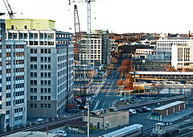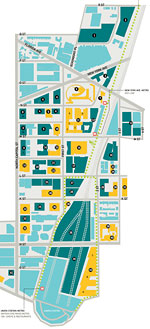NoMA has no parks thanks to flawed upzoning
When DC officials rezoned the land north of Union Station to create NoMA, they triggered the creation of a brand-new neighborhood. Unfortunately, they forgot to leave space for a park, and created an economic dynamic that virtually ruled out any parks. Last week, Tommy Wells introduced a bill to try to fix this glaring omission.
As Michael Neibauer explains in a Business Journal article (unfortunately behind the paywall), NoMA has no parks in its 358-acre territory, a “major oversight.”
Basically, before the rezoning, a number of different property owners had some land that was fairly valuable. After the rezoning, they all had land that was extremely valuable. Then, many of them sold the land to developers. The developers paid a high price, knowing that they were entitled to build 10 FAR on their sites. But that also meant the developers now have to build 10 FAR to cover their investment.
DC created a lot of value when it upzoned the land. But that value all went instantly into the pockets of the current owners of the land. It increased the likelihood of the land being developed, but it also made it almost impossible to ask for any amenities, like parks.
Plus, the height limit means that developers can’t get their 10 FAR by, say, building a 20-story building on half the lot and retaining the rest for a park. DC can’t even give this right to a single property owner for a single park.
This is exactly the mistake Larry Beasley warned against in his recent talk. Instead of simply adding as-of-right height, he suggested coupling higher development with requirement to provide various amenities. This is the approach Montgomery County is using at White Flint, for example. This means that a portion of the economic gain goes to the property owner, but some of it can go to making housing more affordable, or providing parks, or schools, or bike paths.
There are few development sites left and as development proceeds opportunities for a park will dwindle. It’s too bad DC gave away all of its best tools years ago. In the map at right, blue and yellow properties are already built or under construction. The teal spaces represent unbuilt, planned projects; any park would have to displace one of them.
According to the WBJ article, Wells proposes allocating up to $51.5 million in tax revenue from NoMA into a special fund, but only if the revenue exceeds the 2010 level so it doesn’t take away from the District’s budget.
The NoMA BID and local developers support the plan, but perhaps they should also support increasing their tax rates a bit, at least in the future for a number of years, since they will benefit from the park and can sell units for more money (which will also generate more property tax).
And in the future, all cities and towns should avoid making the same mistake. Libertarian-leaning urbanists like Market Urbanism have recommended fewer development restrictions and greater reliance on the free market. In many cases that makes a lot of sense, but the NoMA experience shows a need for at least some mechanism to reserve for public goods some of the value an upzoning generates. Is there a more free market way to handle this?


